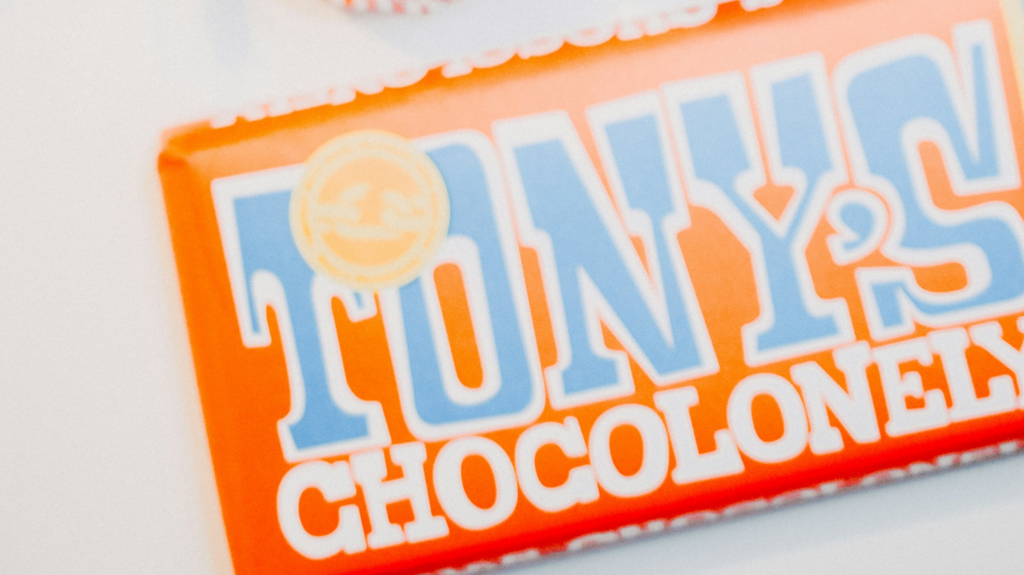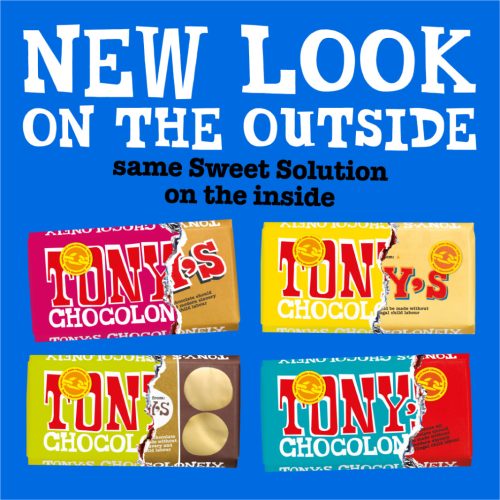How Tony's Chocolonely Rose to Chocolate Stardom
Posted: 03 May 2024

The rise of Tony’s Chocolonely - what made the independent chocolate company so popular and what you can learn from their success.
Back in February, my colleague Joe Baker and I jetted off to Amsterdam to visit Chocoa2024 to gain some up-to-date industry insights and learn about the newest chocolate innovations from across the globe. While there, we thought it’d be rude not to pay a visit the Tony’s Chocolonely flagship store in the heart of the city.
by Michael Rodber
03 May 2024
We witnessed a slew of people queuing around the centre of the store, waiting to get their hands on their very own personalised Tony’s bar. We saw people, out in their masses, circling the stands to sample a white popping candy or dark pretzel toffee. And that got us thinking: What is it about Tony’s Chocolonely that has captured the hearts of a nation in the span of a few years, taking over the shelves of many major retailers? And what lessons can you, as an independent chocolatier, learn and implement?
Tony’s Chocolonely only launched in the UK in 2019, and has since grown into a household name, however, its origins go back much further. Back in 2003, Founder and then-journalist Teun Van De Keuken discovered the exploitation that was plaguing the chocolate industry, bringing it to light on a Dutch TV show, for which he was a presenter and investigative journalist. Following this, he began a publicity campaign, ‘turning himself in’ to local authorities for being complicit in modern slavery by purchasing and consuming chocolate products with child slavery in the production pipeline. As you can imagine, Teun was refused prosecution, so instead set his sights on Nestlé (the main sponsor of the then-upcoming Charlie and the Chocolate Factory film), in the hopes that they would consider producing slavery-free chocolate. With little interest from Nestlé, Teun began production of his own slavery-free chocolate, which became a huge success… the rest, as they say, is history.
The Good, The Bad, and The Chocolatey
From its inception, Tony’s Chocolonely has had a major focus on its ethics and sustainability in both its own chocolate and the chocolate of the wider industry, pushing for new protocols, petitions, achieving B-corp certification and paying additional premiums as well as Fairtrade®. Now, more than ever, consumers are conscious of supporting brands that actively utilise sustainable and ethical packaging and ingredients, which may be an indication of why Tony’s has seen such success in the UK. So if you’re looking to do the right thing as well as give your customers what they want, consider going the extra mile in sustainable packaging and ethical chocolate. Similarly, there has been an increase in demand for buying independent and local, so if you’re a business that fits all those criteria, you’re in luck!
At Keylink, we have plenty of options for those wishing to use chocolates with sound ethics and sustainability approaches to back them up. Callebaut uses the Cocoa Horizons programme, for example, while Veliche Gourmet is Rainforest Alliance certified, and Valrhona is proud to be a B Corporation. You can always ask us about the ethics credentials for your chosen brands, meaning that whichever chocolate you choose, you’ll be able to rightfully claim the same policies as those brands in your recipes (subject to the other ingredients you use, of course), and hopefully, take a leaf out of Tony’s book to help bolster your own success!
Playing up to the Cameras
While we’re definitely not saying you should replicate Teun’s story and attempt to get arrested in order to appear in your local newspaper, there is something to getting your name out there through the means of PR. Back in 2021, Tony’s launched a campaign called ‘Sweet Solutions’. Replicating the bars and packaging of 4 major chocolate brands, with the message to consumers and chocolate companies alike that these chocolates can be made with 100% slavery free chocolate, and still have the same great taste – should they choose to make the change. These bars were limited edition and a great way to get people talking about both the highlighted issues… and Tony’s Chocolonely. Leaflets, posters, pop-up stands, collaborations with other local brands, magazines and local radio slots are all simple ways that you can help get your name out there, depending on the size of your business and your budget. Of course, there are more controversial and creative ways to get the town talking, much like the Sweet Solutions campaign, but we’ll leave it to you to take it to the drawing board!

A Chocolate Mouthpiece
In almost any marketing class, the first case study they’d give you on tone of voice would be that of Innocent, the famous fruit drinks company – the poster child for the personification of a brand. And for good reason, too – they’ve nailed the friendly, cheeky brand trope that has a copycat in almost every industry. Of course, we aren’t talking about Innocent today, though they are a good reference point, we’re talking about Tony’s – and brand voice, imagery, and consistency is something Tony’s does exceptionally well. Customers want brands that they can connect with, brands that they can see as extensions of themselves, brands that have values that closely align with their own. Tony’s does just that.
Their tone of voice, generally speaking, is a little quirky and informal, without going as far as to undermine their message. An outsider, a positive force for change, an industry leader who is truthful about the industry as well as their own business, the brand defines themselves as “an impact company that sells chocolate” with “making all chocolate 100% slavery-free”. This branding is woven throughout the entirety of their copy, their website, mission, story, and even packaging and bars – with their unequal pieces representing the unfair share of profit in chocolate, and the red representing the urgency of the situation.
As we’re sure you can tell, Tony’s have built their brand around one core idea and message, and applied this to every aspect of branding and marketing. If you’re a chocolate business with a key theme or value, such as veganism, don’t be afraid to really lean into it and allow your customers to buy into what your company is all about. Consider all elements of your branding and what common threads can run through your company, from the shape of your bar to the layout of your shop…
Just popping to the shop
Of course, it’s not just the brand and the personalisation visitors come for at the Tony’s superstore in Amsterdam – it’s also the experience, too. Full of fantastical chocolate bar displays, the shop is reminiscent of the aesthetics of Charlie and the Chocolate Factory, perfect to tug on the nostalgia strings of 3 generations of chocolate and film fans alike. Not only is nostalgia a great way to connect to customers, but for many outside of the chocolate world, it’s this weird and wonderful experience that’s closely associated with a chocolate shop. There’s no one-size-fits all when it comes to how you decorate or layout your stall, but it is worth keeping in mind the customer experience when it comes to designing your store. A few simple, playful elements to turn it from a simple place to buy and into a fun shopping experience can go a very long way to ensuring you create a talking point and generate repeat business.
However, when we visited, it became clear that the major pull for visitors was their personalisation station for making your own chocolate bars. You can pick your own chocolate, inclusions, colour of packaging, and text on the bar, all from a touch screen with a view of the chocolate machinery and chocolatiers hard at work. And if you’re lucky (or wait long enough) you can catch a glimpse of your personalised bar being created. It’s both this brand recognition and positioning that makes tourists from far and wide willing to pay a premium for their chocolate bars, as well as the novelty of a unique experience tailored to them. If personalisation is something that you have the time and resources for, it may be worth considering adding personalised chocolate to your product lines. If you’re looking for personalised moulds, consider investing in your very own Mayku FormBox, which can produce custom formed moulds in a matter of minutes!
And as a final incentive for travelling customers, Tony’s superstore offers an exclusive ‘Rainbow Pack’ that can only be bought from the superstore, meaning if you’re a big fan of theirs, you’ll definitely want to pay them a visit! Exclusivity is only as valuable as it is perceived, but making the most of “limited edition” runs of flavours or designs is a surefire way to retain the interest of your customers!
We loved our trip to Amsterdam and exploring all the different chocolate shops and products on offer… but we love seeing our customers’ chocolate even more! Be sure to tag us in your chocolate creations on TikTok, Instagram and Facebook!

Michael is a Marketing Executive with a penchant for punk rock, cheese, and indoor bouldering.
His favourite chocolate is Valrhona Tanariva.
.svg)